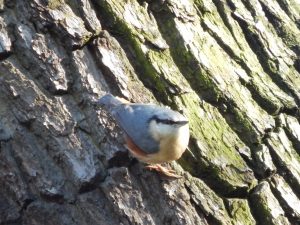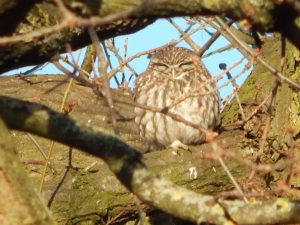Identifying by sight
- You don’t necessarily need binoculas to get started. You can view many birds in the city at close range.
- Learn to identify robins, blackbirds and pigeons – then you can use the RSPB’s brilliant online search function to identify the bird that you’ve seen based on its size and whether it is larger or smaller than a robin, blackbird or pigeon!
- Notice the colours of the bird, the shape of its head and wings. As you get more familiar, the way that it moves and whether you see it on the ground, in flight or in a tree may help with your identification.
- If you’re able to take a photo of the bird it will give you more time and a better chance of a positive identification (sometimes I think a camera with a good zoom is as good if not better than using binoculars, especially when you’re learning and want to be able lookup what you’ve seen later on.
Identifying by sound
- Birds can be identified by sound as well as sight. Audio record a bird that you can see singing with your phone, that way you can link the sound a bird makes to what it looks like. If you’re not sure what the bird is you can look it up later or with a pocket guide/app while you’re out birding. This is a great way of learning to identify a bird by its call as well as by what it looks like. (It is common for birders to make a list of birds they identified on a walk, including birds that they have heard, even if they didn’t see it.)
- As you get more advanced you could try and record the different sounds birds make; song, calls and distress alarm, creating your own audio library on your phone as a handy reference.
- Keep a list of the birds that you see and recognise. This will help build up you’re memory and over the seasons notice changes to what you see and when. You can then do some research into why! (e.g. birds migrating to breed)
- Go out watching with an experience birder who can point out sound and sight identifyers to you. We recommend Peter White’s bird walks in south London. Join our mailing list to be notified of WitC bird walks.
- Practice is all it takes! The more you watch birds the more you’ll be able to identify and build up a memory of what you’re seeing and hearing.
Songs tend to be more melodic tunes, alarms tend to be short, abrupt sounds, calls can be very varied.
Amongst European birds its the male of the species who sings, not the female. Songs are used to attract mates and to demark territory.
Alarms/distress calls
Alarms are used to warn other birds (and indeed animals) that there is a threat. The alarm call can vary depending on whether the threat is on the ground, in the air and how close it is. Alarm calls may also be made when birds are being aggressive or chasing other birds away. If you hear a flock of birds making distress calls it is likely an indicator that there is a predator around and can alert you to the presence of a raptor, such as a Sparrowhawk.
Begging calls
Sounds made by young birds in the nest to request food and by juveniles who have recently left the nest. This can help you to locate a nest, useful if you want to observe feeding or identify what the young look like.
Contact calls
Sounds made by birds to signal with one another, in relation to feeding, travelling in a flock or mates communicating with each other.
Flight calls
Many birds have calls that they only make during flight, to indicate their presence to other birds while moving.


